A Numerical Study on the Effects of the Geometry and Location of an Inserted Wire on Methane–Air Flames in a Micro–Burner
Abstract
:1. Introduction
2. Numerical Approach and Boundary Conditions
3. Results and Discussions
3.1. Mesh Study and Validation
3.2. Effect of the Wire’s Diameter on Flame Characteristics
3.3. Effect of the Wire’s Location on Flame Characteristics
4. Conclusions
Author Contributions
Funding
Institutional Review Board Statement
Informed Consent Statement
Data Availability Statement
Conflicts of Interest
References
- Chou, S.K.; Yang, W.M.; Chua, K.J. Development of micro power generators—A review. Appl. Energy 2011, 88, 1–16. [Google Scholar] [CrossRef]
- Aravind, B.; Khandelwal, B.; Ramakrishna, P.A.; Kumar, S. Towards the development of a high power density, high efficiency, micropower generator. Appl. Energy 2020, 261, 114386. [Google Scholar] [CrossRef]
- Importance of Methane. 2021. Available online: https://www.epa.gov/ (accessed on 20 December 2021).
- Esrafilzadeh, D.; Zavabeti, A.; Jalili, R.; Atkin, P.; Choi, J.; Carey, B.J.; Brkljaca, R.; O’Mullane, A.P.; Dickey, M.D.; Officer, D.L.; et al. Room temperature CO2 reduction to solid carbon species on liquid metals featuring atomically thin ceria interfaces. Nat. Commun. 2019, 10, 865. [Google Scholar] [CrossRef] [PubMed]
- Yang, W.M.; Chou, S.K.; Shu, C.; Li, Z.W.; Xue, H. Combustion in micro-cylindrical combustors with and without a backward facing step. Appl. Therm. Eng. 2002, 22, 1777–1787. [Google Scholar] [CrossRef]
- Chen, G.; Chao, Y.; Chen, C. Enhancement of hydrogen reaction in a micro-channel by catalyst segmentation. Int. J. Hydrogen Energy 2008, 33, 2586–2595. [Google Scholar] [CrossRef]
- Ronney, P. Analysis of non-adiabatic heat-recirculating combustors. Combust. Flame 2003, 135, 421–439. [Google Scholar] [CrossRef]
- Baigmohammadi, M.; Sarrafan-Sadeghi, S.; Tabejamaat, S.; Zarvandi, J. Numerical study of the effects of wire insertion on CH4 (methane)/Air pre-mixed flame in a micro combustor. Energy 2013, 54, 271–284. [Google Scholar] [CrossRef]
- Baigmohammadi, M.; Tabejamaat, S. Experimental study on the effect of external thermal pattern on the dynamics of methane-oxygen and methane-oxygen carbon dioxide premixed flames in non-adiabatic meso-scale reactors. Int. J. Therm. Sci. 2019, 137, 242–252. [Google Scholar] [CrossRef]
- Baigmohammadi, M.; Tabejamaat, S.; Yeganeh, M. Experimental study of methane-oxygen premixed flame characteristics in non-adiabatic micro-reactors. Chem. Eng. Process. 2019, 142, 107590. [Google Scholar] [CrossRef]
- Baigmohammadi, M.; Tabejamaat, S.; Kashir, B. A numerical study on the effects of hydrogen addition levels, wall thermal conductivity and inlet velocity on methane/air pre-mixed flame in a micro reactor. Energy Equip. Syst. 2014, 2, 103–119. [Google Scholar]
- Baigmohammadi, M.; Roussel, O.; Dion, C.M. A Numerical Study of Lean Propane-Air Flame Acceleration at the Early Stages of Burning in Cold and Hot Isothermal Walled Small-Size Tubes. Flow Turbul. Combust. 2019, 104, 179–207. [Google Scholar] [CrossRef] [Green Version]
- Alipoor, A.; Mazaheri, K. Studying the repetitive extinction-ignition dynamics for lean premixed hydrogen-air combustion in a heated microchannel. Energy 2014, 73, 367–379. [Google Scholar] [CrossRef]
- Ju, Y.; Xu, B. Effects of channel width and Lewis number on the multiple flame regimes and propagation limits in meso-scale. Combust. Sci. Technol. 2006, 178, 1723–1753. [Google Scholar] [CrossRef]
- Senchenko, S.; Bychkov, V.; Liberman, M. Stability limits of curved stationary flames in cylindrical tubes. Combust. Sci. Technol. 2001, 166, 109–130. [Google Scholar] [CrossRef]
- Tsai, C.H. The asymmetric behavior of steady laminar flame propagation in ducts. Combust. Sci. Technol. 2008, 180, 533–545. [Google Scholar] [CrossRef]
- Jackson, T.B.; Virkar, A.V.; More, K.L.; Dinwiddie, R.B.; Cutler, R.A. High-Thermal-Conductivity Aluminum Nitride Ceramics: The Effect of Thermodynamic, Kinetic, and Microstructural Factors. J. Am. Ceram. Soc. 2005, 80, 1421–1435. [Google Scholar] [CrossRef]
- Rahman, M.M.; Miettinen, A.; Siikonen, T. Modified Simple Formulation on a Collocated Grid with an Assessment of the Simplified Quick Scheme. Numer. Heat Transf. Part B Fundam. 1996, 30, 291–314. [Google Scholar] [CrossRef]
- Li, J.; Chou, S.K.; Li, Z.W.; Yang, W.M. Characterization of wall temperature and radiation power through cylindrical dump micro-combustors. Combust. Flame 2009, 156, 1587–1593. [Google Scholar] [CrossRef]
- Martinez, S.; Baigmohammadi, M.; Patel, V.; Panigrahy, S.; Sahu, A.B.; Nagaraja, S.; Ramalingam, A.; Heufer, K.A.; Pekalski, A.; Curran, H.J. A comprehensive experimental and modeling study of the ignition delay time characteristics of ternary and quaternary blends of methane, ethane, ethylene, and propane over a wide range of temperature, pressure, equivalence ratio, and dilution. Combust. Flame 2021, 234, 111626. [Google Scholar] [CrossRef]
- Goodwin, D.G.; Speth, R.L.; Moffat, H.K.; Weber, B.W. Cantera: An Object-Oriented Software Toolkit for Chemical Kinetics, Thermodynamics, and Transport Processes; Version 2.5.1; 2021; Available online: https://www.cantera.org (accessed on 20 December 2021). [CrossRef]
- Smooke, M.; Giovangigli, V. Formulation of Test Premixed and Nonpremixed Test Problems, Reduced Kinetic Mechanisms and Asymptotic Approximations for Methane-Air Flames; Springer: Berlin/Heidelberg, Germany, 1991; Volume 384. [Google Scholar]
- Nagaraja, S.S.; Sahu, A.B.; Panigrahy, S.; Curran, H.J. A fundamental study on the pyrolysis of hydrocarbons. Combust. Flame 2021, 233, 111579. [Google Scholar] [CrossRef]

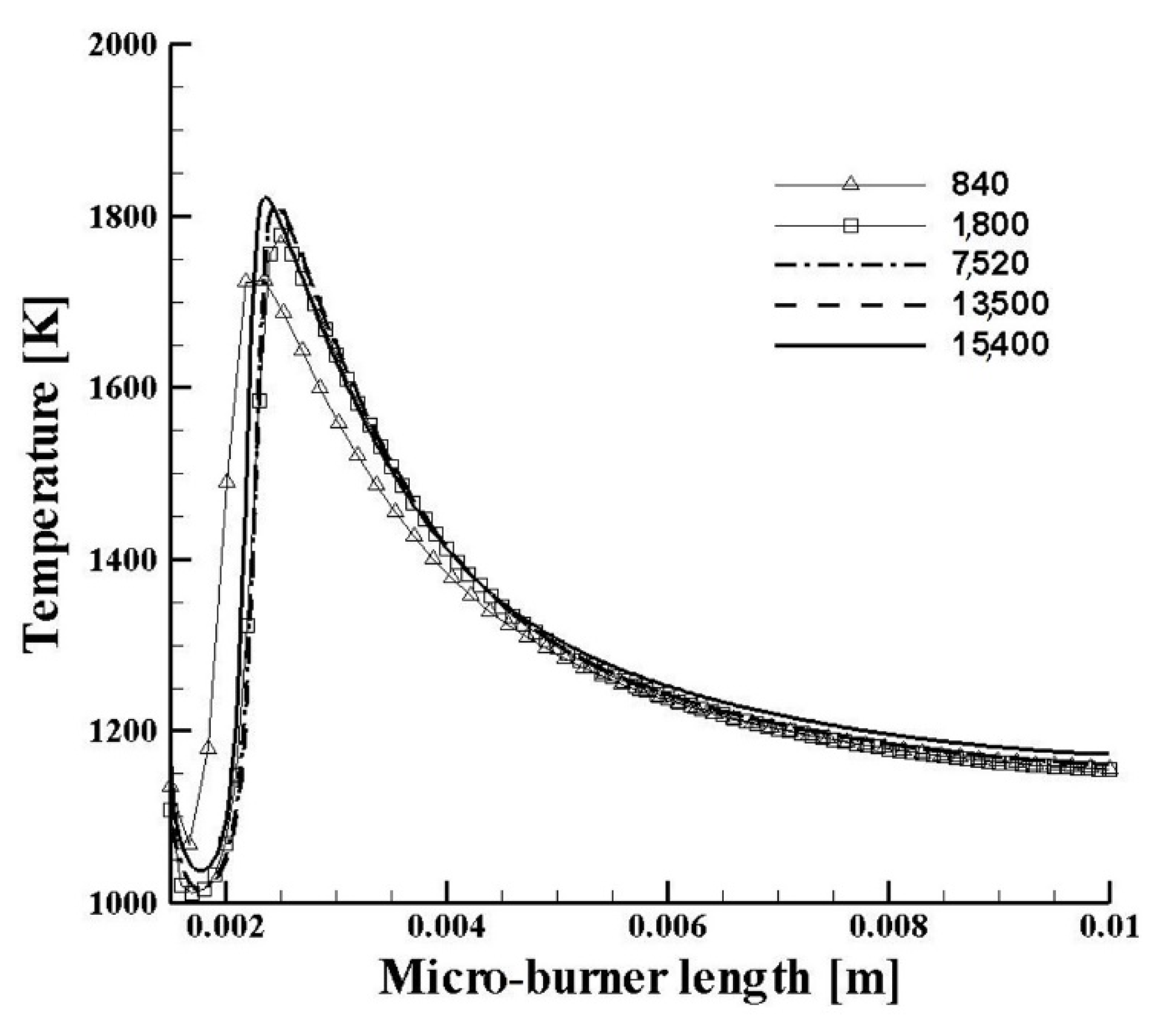
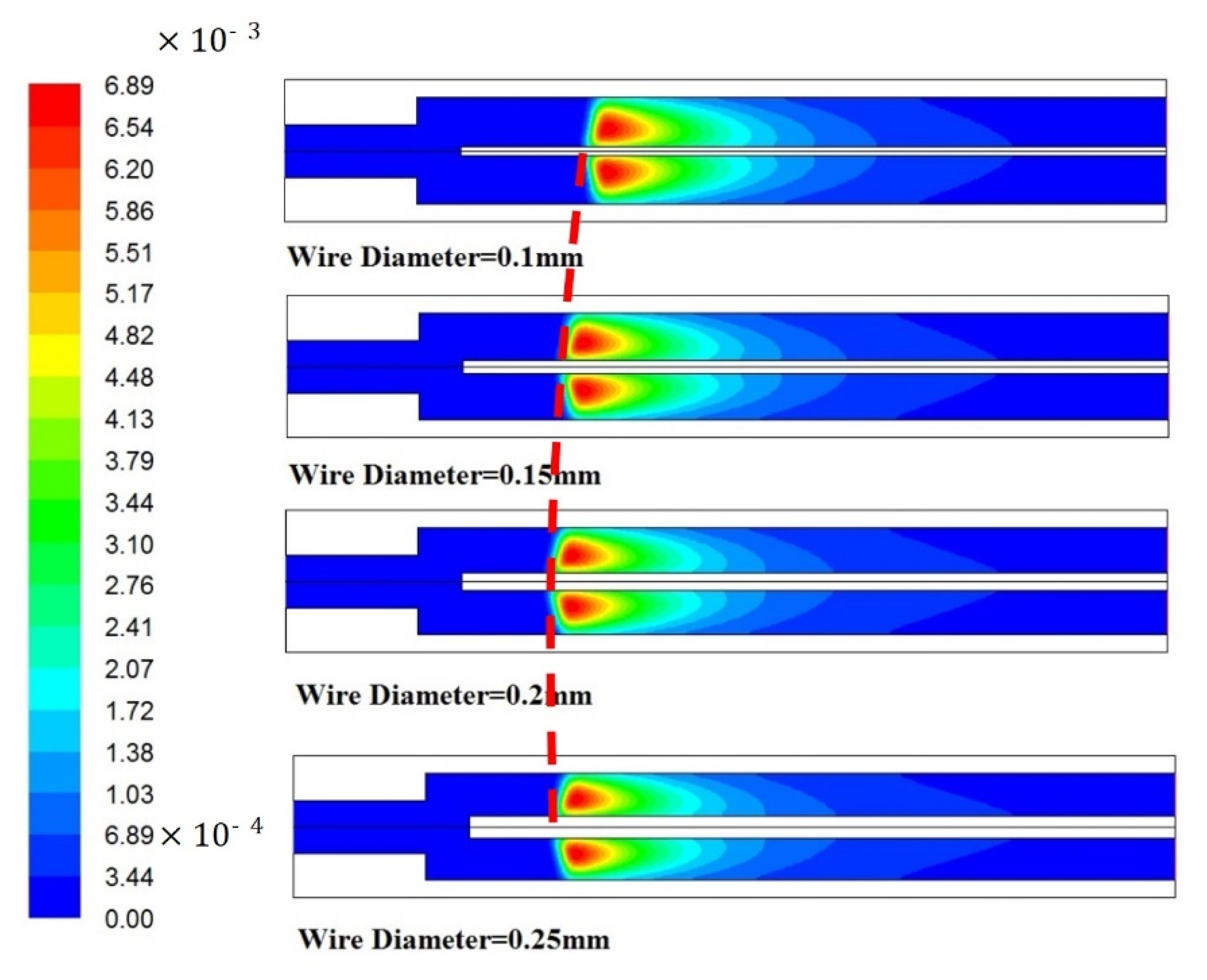
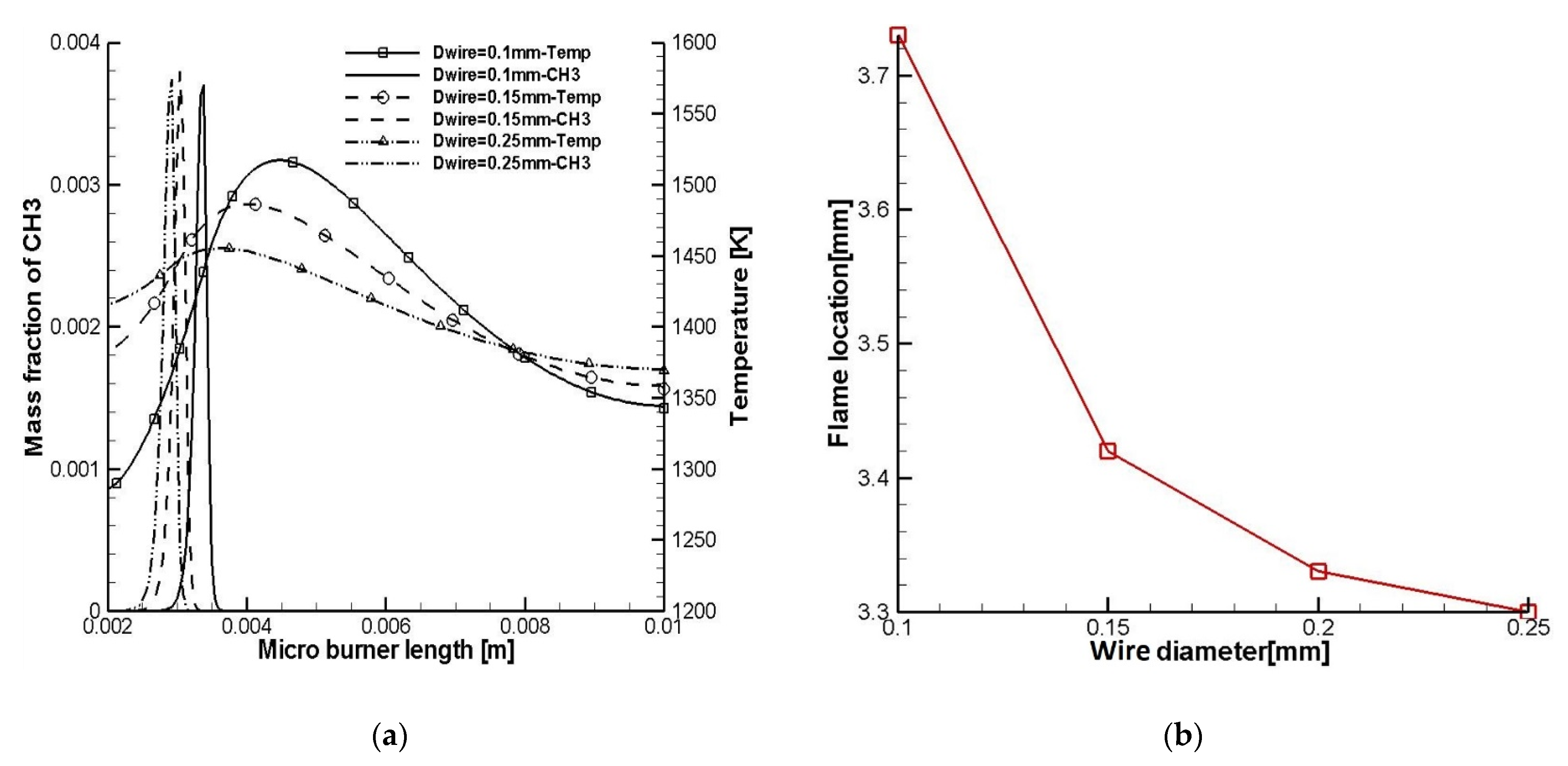

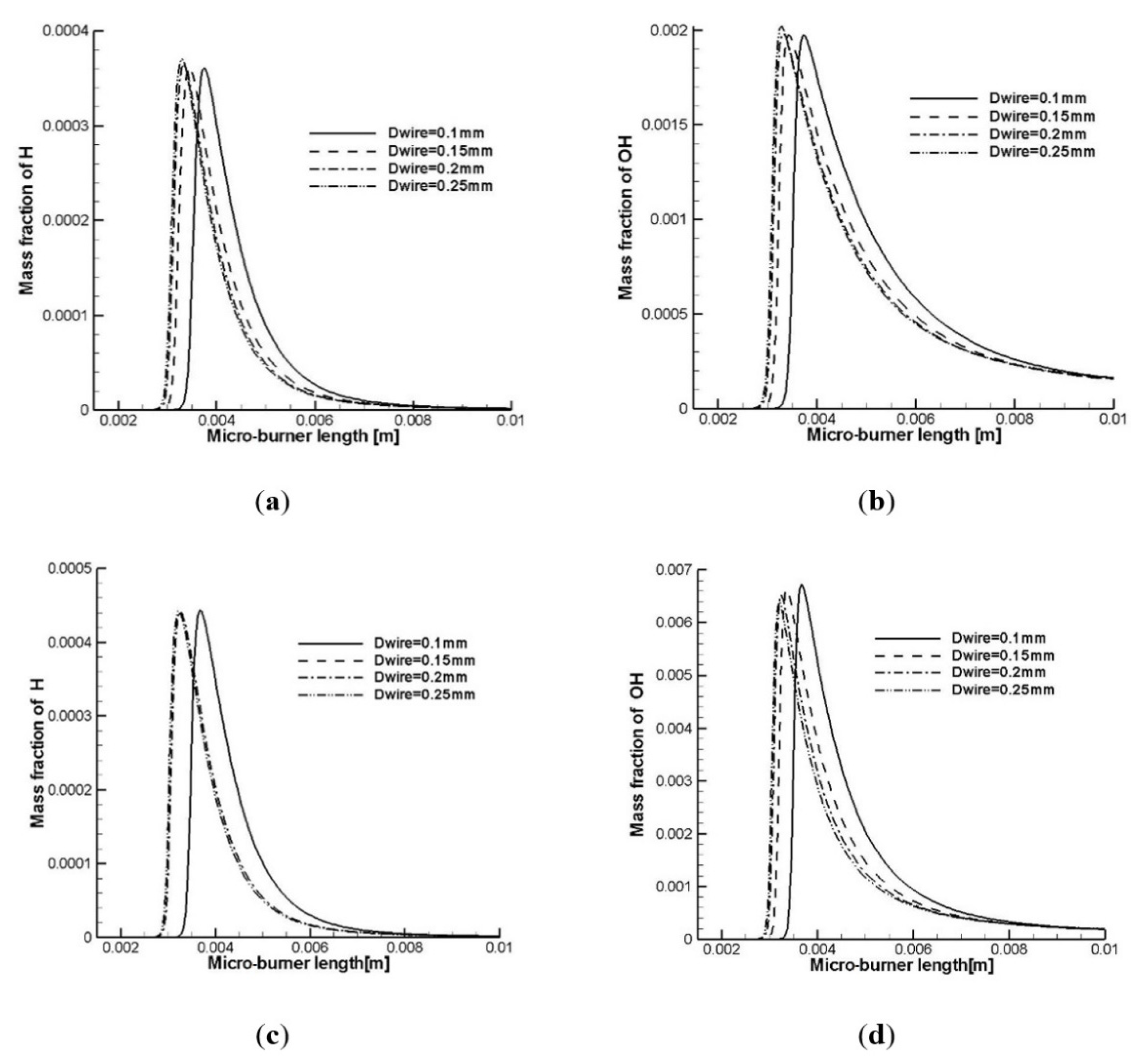
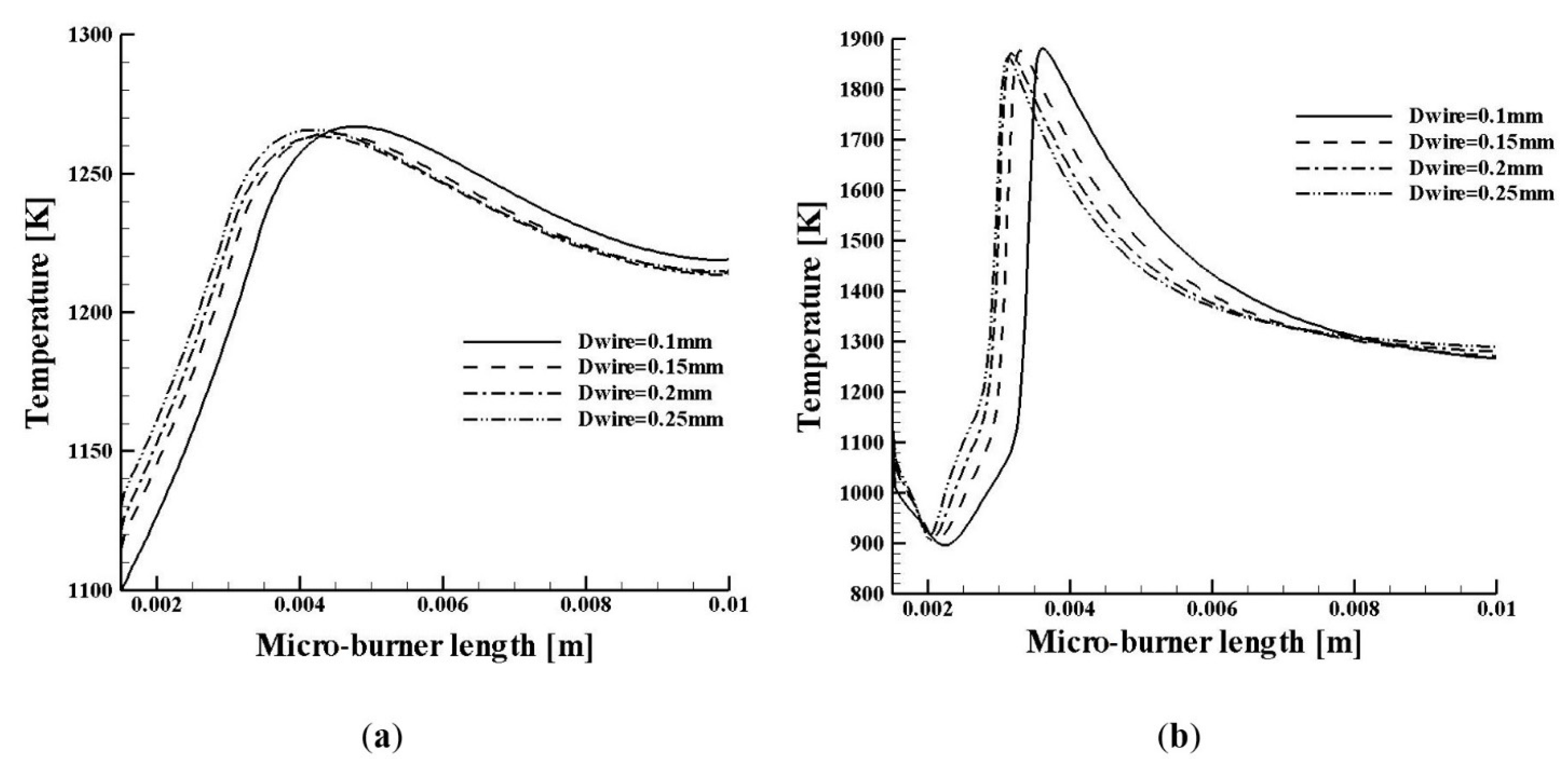
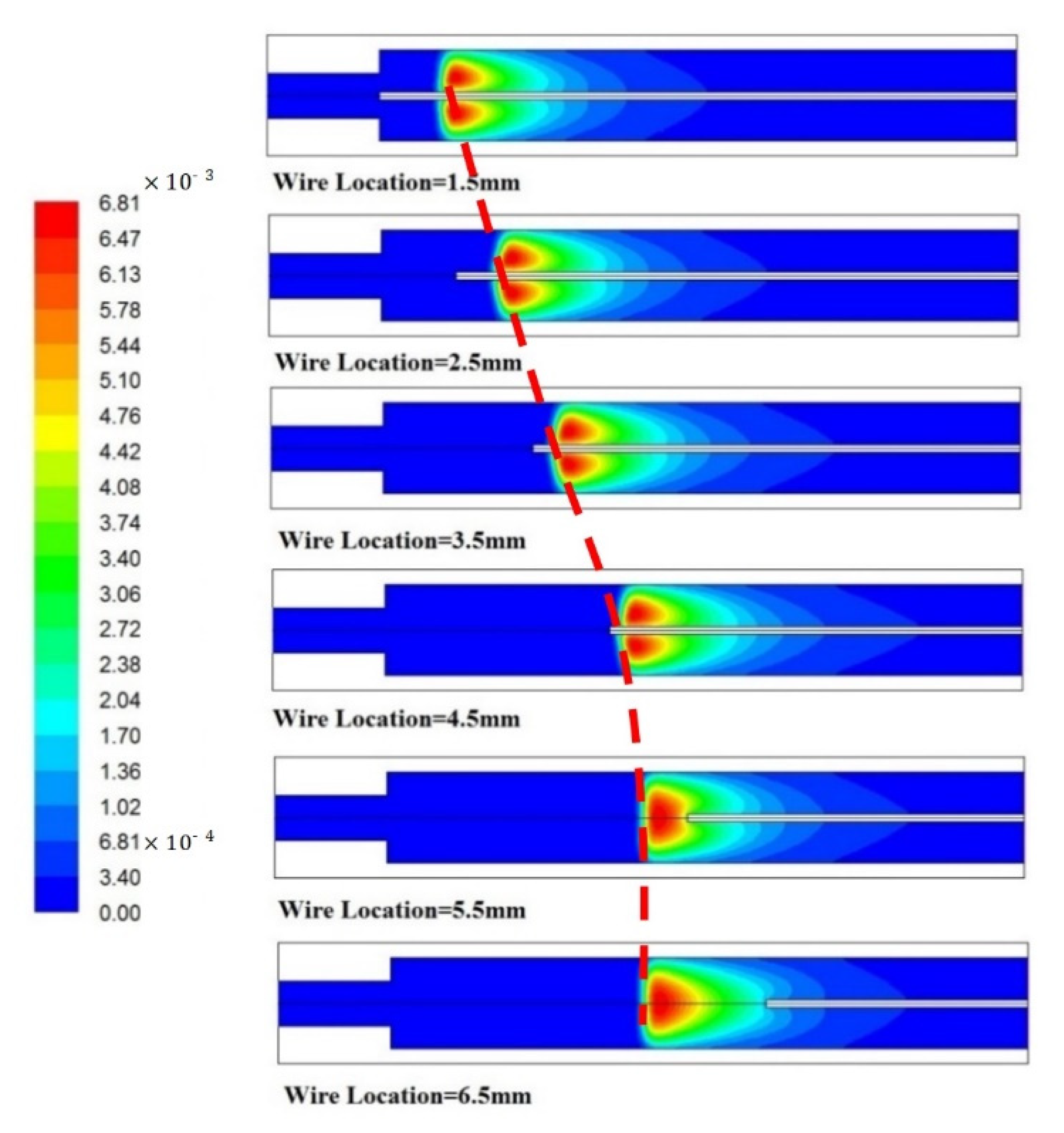

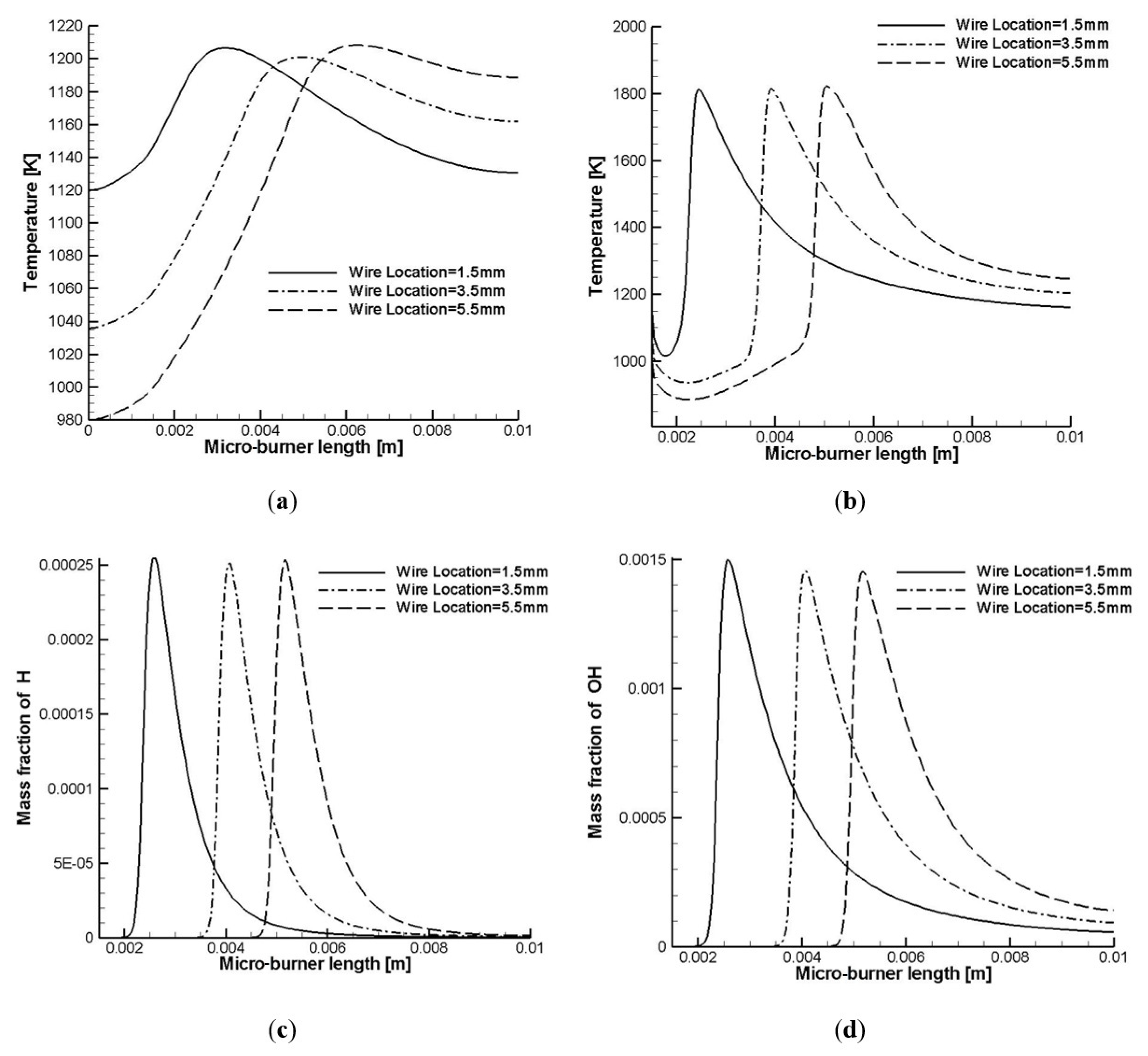
| Inlet velocity (Vin) | 2.8 m/s |
| Wire’s thermal conductivity (Kwire) | 170 W/m·K |
| Wall’s thermal conductivity (Kw) | 20 W/m·K |
| External heat transfer coefficient (hout) | 5 W/m2·K |
| External emissivity coefficient (e) | 0.2 |
| Equivalence ratio (φ) | 0.9 |
Publisher’s Note: MDPI stays neutral with regard to jurisdictional claims in published maps and institutional affiliations. |
© 2021 by the authors. Licensee MDPI, Basel, Switzerland. This article is an open access article distributed under the terms and conditions of the Creative Commons Attribution (CC BY) license (https://creativecommons.org/licenses/by/4.0/).
Share and Cite
Zarvandi, J.; Baigmohammadi, M.; Tabejamaat, S. A Numerical Study on the Effects of the Geometry and Location of an Inserted Wire on Methane–Air Flames in a Micro–Burner. Energies 2022, 15, 93. https://doi.org/10.3390/en15010093
Zarvandi J, Baigmohammadi M, Tabejamaat S. A Numerical Study on the Effects of the Geometry and Location of an Inserted Wire on Methane–Air Flames in a Micro–Burner. Energies. 2022; 15(1):93. https://doi.org/10.3390/en15010093
Chicago/Turabian StyleZarvandi, Jalal, Mohammadreza Baigmohammadi, and Sadegh Tabejamaat. 2022. "A Numerical Study on the Effects of the Geometry and Location of an Inserted Wire on Methane–Air Flames in a Micro–Burner" Energies 15, no. 1: 93. https://doi.org/10.3390/en15010093
APA StyleZarvandi, J., Baigmohammadi, M., & Tabejamaat, S. (2022). A Numerical Study on the Effects of the Geometry and Location of an Inserted Wire on Methane–Air Flames in a Micro–Burner. Energies, 15(1), 93. https://doi.org/10.3390/en15010093






